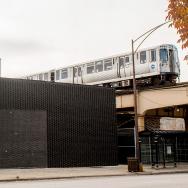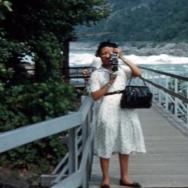For years, Sydney Chatman rehearsed wherever she could, converting her own living room into a stage, transforming a room at the local community center and even reimagining a local muffler shop.
When the University of Chicago opened the Green Line Performing Arts Center this past Saturday, it gave the writer and director—as well as countless other local artists—a permanent anchor for their creative pursuits.
“Being in a space like that feels like home,” said Chatman, who teaches theater at the University of Chicago Charter School. “I’ll be able to really plant myself.”
Chatman is the founder of the Tofu Chitlin’ Circuit, a producing performance collective on Chicago’s South Side. On the evening of Nov. 10, four of its young members commanded a room inside the center, donning aviator caps and goggles, golden capes and light-up shoes—an ode to both black girlhood and pioneering pilot Bessie Coleman.
The group was one of several invited to the opening of the new Washington Park performance hub, a celebration that drew nearly a thousand visitors to the black brick building tucked underneath the CTA rail line. Musicians avery r. young & de deacon board stomped the main stage, sparking an impromptu dance party. Bomba con Buya thumped on drums, showcasing the traditional Puerto Rican genre that inspired the ensemble’s name.
Part of the Arts Block project, the 6,600-square-foot facility represents the latest step by the University of Chicago’s Arts + Public Life initiative to help reinvigorate this stretch of Garfield Boulevard. Less than 300 feet away stands the Arts Incubator, which in the past five years has hosted more than two dozen resident artists, in addition to events and exhibitions.
The Green Line Performing Arts Center is also the latest tenant on a historic block—one that over the past century has been home to a movie theater, restaurants and various nightclubs, including one owned by boxer Joe Louis.
“When you see it come to fruition, that’s a beautiful thing,” said actor and director Ron OJ Parson, a resident artist at UChicago’s Court Theatre. “In that sense, it is very emotional. A new space on the South Side, it’s special.”
Fostering community connections
The space was designed by Morris Architects Planners and local artist Theaster Gates, a UChicago faculty member who solicited guidance from the local arts community, including Chatman and Parson. Gates is the founder and former director of Arts + Public Life, an initiative launched in 2011 to foster stronger connections between the University and the artists working in the surrounding neighborhoods.
The first theater to open in the area in decades, the Green Line Performing Arts Center contains the E&A Theatre, a black-box venue with 80-plus seats; the Harris Studio, which can host rehearsals as well as performances; as well as a lobby and a courtyard for outdoor screenings and other programming. The outside of the facility is adorned with a black brick façade; when the sun goes down, the building’s lights shine out through the gaps.
But even more important is the center’s community-facing philosophy. By drawing people from across the spectrum of performance arts, the space can become a catalyst for creativity— leveraging talent in one individual to spark inspiration in another.
“You’ll have someone who’s working in the dance studio,” Chatman said, “and you may hear some music, or you may see some movement, and that can generate some ideas for your work.”
Parson highlighted the fact that the center will offer technical training in the arts, in addition to serving as a space for local theater groups and independent creatives. A facility that has state-of-the-art lighting and equipment gives young people in the community hands-on training and opportunities to apprentice and intern.
That, in turn, can increase minority representation in light, sound and set design—numbers that have not grown, Parson said, even as local productions have tried to become more inclusive in their hiring and casting.
“People are looking for designers of color,” he said. “When you look for a designer and you want to do a show that’s Afro-centric or Latino, when you can find those designers that have the cultural background, that helps. We want to educate and entertain at the same time.”
Lori Berko, deputy director of Arts + Public Life, said the Green Line Performing Arts Center will not only build on existing partnerships with South Side artists and art organizations, but also incubate new relationships. Arts + Public Life’s artist residency programs, for example, will soon expand to include theater companies, ensembles and collectives.
“We are beyond excited to activate another much-needed theater space in the neighborhood,” Berko said. “That this opening drew over 900 people despite cold weather demonstrates the robust cultural landscape of the South Side. It feels amazing looking around and seeing everyone that’s coming into this space, asking ‘When is the first program? How can I get involved?’”
‘A story book opening’
The opening also may help spark a once-lively South Side corridor. On the same block in August 1911, the Louise Amusement Company purchased what was then the President Theater, a 781-seat venue that it ran for more than a decade. By 1936, the space had transformed into a nightclub, operating intermittently over the next several years as both Dave’s Cafe and Swingland Cafe.
The Rhumboogie Cafe debuted to great fanfare on April 17, 1942, one that the Chicago Defender called “a story book opening” attended by Louis and “a brilliant array of celebrities.” Describing a packed house that sent crowds flowing to nearby venues, the newspaper was bold in its prediction for the Rhumboogie: “People of all races and from all walks of life fought to get a chance to see the premiere of what is destined to become Chicago’s brightest night spot.”
But the club was destroyed by a New Year’s Eve fire three years later. Sparked by what officials described at the time as a “carelessly tossed cigarette,” the fire caused $19,000 in damage. The Rhumboogie soon reopened, with Louis taking over as sole owner in December 1946, but didn’t survive through the first half of the following year.
Club DeLisa, another prominent club, fared better a half-mile away at the corner of State Street and Garfield Boulevard. Founded in 1934, it lasted nearly a quarter-century before closing its doors. When it officially shuttered, longtime bandleader Red Saunders said: “I haven’t taken a vacation since 1952. I guess I’ll take one now.”
On Nov. 10, the block felt animated once again. And after hours of other performances, Chatman’s girls declared what sounded almost like a mission statement: “Fly, girl, fly—up in the sky, like fireworks on the Fourth of July.”
“Being in a space that’s designed with your ideas in mind is really going to help,” Chatman said. “Because now, we can really spread out, really breathe and really flourish.”

